No Reproductions
Genuine reclaimed items only

Antique doors are a great way to add character to a house, but when buying an older door, it’s important to be aware of the potential presence of lead paint. Lead paint was only banned in the UK in 1992, so before you refinish any antique door, it’s crucial that you check it first.
Testing an antique door for lead paint is fairly easy to do. You can buy a lead testing swab kit online or at a DIY shop that will quickly and easily help you determine whether or not there is lead present on your door.
Doors are high traffic areas, and lead paint can become dangerous if it starts to chip or break down. So if the test comes back positive, you will need to remove the paint with a chemical paint stripper.
West Yorkshire Architectural Antiques are specialists in genuine, antique doors and door furniture. All of our doors are genuine reclaimed items, as we don’t sell reproductions or artificially aged products. If you’re searching for the ideal finishing touch to your home, take a look at our current stock of antique doors.